The 2016 Top 100 Dealers

As the Boating Industry Top 100 celebrates its 12th year, the dealers on the list are stronger than they have been since before the Great Recession.
The Top 100 and Hall of Fame reached nearly $2.7 billion in total revenue in 2015, surpassing last year’s total by more than $100 million. It was the third-highest total in the history of the Top 100 and the best since 2008.
These dealers also faced stiff competition to make the list, with the highest number of applications since the recession. From the thousands of dealers in North America – and hundreds of nominations – these 100 dealers are the best of the best.
As a group, the Top 100 sold 27,141 boats, a 17 percent increase from 2014. They sold 5,142 engines, a 4 percent increase. All this while maintaining healthy profits, industry-leading CSI scores and strong turn rates.
On the following pages, you’ll find key stats and benchmarks from the Top 100, along with some of the best practices from these elite dealers.
Following that, you can read about what made OneWater Marine Holdings the 2016 Top 100 Dealer of the Year, as well as the Best in Class winners, Editor’s Choice dealerships and the five Hall of Fame companies. Finally, you can also see the full list of the Top 100, with the Top 20 ranked, and the rest appearing in alphabetical order.
Best practices of the Top 100
Although the Top 100 experienced great financial success in 2015, the program is about more than dollars and cents.
Top 100 dealers are chosen for their business acumen, marketing, efficiency, industry advocacy, service best practices and more. These are dealers who not only sell plenty of boats, but also promote the boating lifestyle by delivering standout customer service and experiences.
These are just a few of the best practices that helped this year’s Top 100 stand out from the crowd. For more best practices, be sure to check out the Best in Class winner profiles starting on p. 46.
Digital file sharing
Texas Marine created a file share network among all of its computer users across its three locations.
“With the help of our IT company, we made significant upgrades to our PC and network infrastructure,” says President Mike Hebert. “We linked all computer users together using a domain system through our primary server. All employees now have customized access to files shared among other employees.”
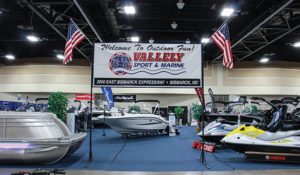
This system allows some employees to immediately access files updated by employees at another location, while at the same time managing the process so that no employee has access to any documents to which they are not authorized.
The file share network has immediately increased the productivity of Texas Marine’s employees, cut down on the amount of time spent on emails and increased customer satisfaction due to reductions in delays and miscommunication.
Boat shows that educate
Boat shows may be evolving, but that doesn’t they aren’t still an important part of growing business, says Vallely Sport & Marine.
“In our market and in markets across the country boat show attendance has been diminishing in the last five years, but the amount of quality buyers at the shows seems to stay strong,” says General Manager Josh Vallely.
Whereas boat shows used to be about showing the “latest and greatest” products, now it’s more about branding and helping customer understand why they should do business with Vallely. While attendance is down, that means salespeople have more time to spend with each potential customer.
“At every show we basically take our dealership on the move. We fully staff our booth with sales consultants, manufacturer reps, pro-fisherman or athletes, F&I personnel, and parts and accessory consultants,” Vallely says. “This staffing arrangement has worked great for us. Manufacturer’s reps are great for asking general product questions and allow our sales consultants to focus on selling product.”

At every show, Vallely brings an enclosed trailer it has converted into a full-service closing and F&I office, providing confidentiality and a sense of professionalism.
Frequent meetings before the show and daily updates during the event makes sure the staff are up to speed on pricing, promotions, competitive products and other pertinent show information.
“During these quick meetings we can review the previous day’s performance as well as any adjustments that need to be made,” Vallely says. “By doing this we can adjust to any unexpected occurrences immediately and not have to wait unit next year’s show, when it is too late!”
Embracing fishing
With a name like Angler’s Choice Marine, the Martinsville, Va., dealer knows that embracing its fishing roots is an important part of its success.
“We have a very strong Angler’s Choice Team Tournament Trail that has been recognized as one of the top dealer sponsored tournament trails in the country,” says Owner Nick Loganadan. “We had 16 tournaments last year and gave away a new Mercury-powered Ranger boat and more than $150,000 in cash and prizes. We cater to as many as 200 boats per tournament. That is 400 anglers in one weekend!”
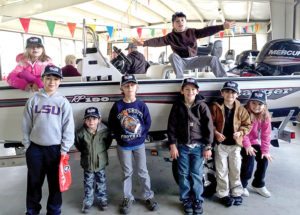
During the tournaments, the Angler’s Choice team serves meals to every fisherman by name. The dealership currently has 850 anglers on its tournament roster.
“It is a very wholesome environment that encourages bonding,” Loganadan says. “Our employees work every tournament and interact with the fishermen. If someone has a break down, we keep an extra tow vehicle available to pull a boat back to the dealership. This puts us on the front line of customer service.”
Not only does it build loyalty with those that watch and participate in the tournaments, the company also uses photos and video from the events on social media and its website, which receives 2 million page views and 30,000 unique visitors every month.
Leveraging outside experience
When it came time to hire a new salesperson, the Blue Springs Marine sales manager sought to hire outside the industry and train them in the company’s ways. With a market based around many private lake properties, a retired real estate agent was an attractive addition.
“He is highly motivated and aligns with our goals of creating relationships with boating friends not just moving inventory,” says President Jeff Siems. “We are focused on building people in the boating lifestyle.”

With his past experience, he has access to all properties being sold and recently sold on the private lake communities.
“We promote our services to brokerage boats for people leaving the lake and then after a property is sold we then contact the new buyers promoting our services and boats,” Siems says. “We feel that if they are buying a lake property they have a high interest in the boating lifestyle, making them high-interest buyers.”
With used boats in high demand, the sales team also works with property buyers and sellers, and its existing service customers to identify customers looking to sell or upgrade their boats.
“This has given us access to more trades and brokerage boats to sell,” Siems says. “With the implementation of a more complete lead management system we now have a database of people looking to sell or buy used boats. We now sell 80 percent of all our used boats before we even get them posted online.”
Tracking and measuring service
Spicer’s Boat City has developed a service tracking and dispatching system that relies on Microsoft Outlook and Excel to keep things running smoothly.
To track efficiency, Spicer’s developed a spreadsheet in Excel that allows it to look at the total hours the tech works, splitting the month up from the 1-15 and 16-31.
“This allows us to see where we stand compared to previous years and indicates if we are having a workflow issue,” says President Phillip Spicer. “We separate our technicians between retail technician and rigger (assembly technicians). The reason we do this is the riggers always work on new product that the sales department sells and the retail technician work on product that has left here. Also the riggers work is mostly repetitive and the work is flat rated. The riggers are constantly doing the same project over and over, whereas a retail tech may only do the same job a few times a year.”
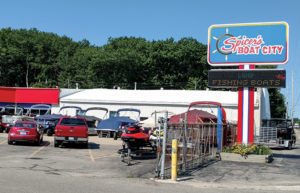
Dividing them allows Spicer’s to track how many hours they work and the amount of billed hours vs. amount of hours worked and the technician’s efficiency each month. The management team uses the information to see how much time is being wasted in the shop, as well as if they need to improve workflow, or hire additional staff.
When it comes time to schedule, Spicer’s uses three calendars in Outlook: a retail service calendar, a rigging calendar and a dockside calendar.
“They are all shared so everybody who has email at the store can see, but each person has different permissions so they can view but not delete or change,” Spicer says. “Each calendar has color coding options so at a glance you can tell what is going on with a product. For example a salesperson can look at customer and see the status just by looking at the color of the customer.”
The retail calendar is used for all retail work, same day appointments and deliveries that need to be dropped off or picked up. To dispatch work, the shop manager works closely with the service advisors to see that products are going in, in a timely manner and to let the service advisors know how long a customer can expect before they get their product back. The rigging coordinator works with sales on a timeline of how long before a new sale can go, makes sure product is ready on time, and schedules drivers to deliver product, Spicer says.
Managing turn rate
When creating its annual inventory forecasting plan, The Sportsman bases it on the previous two-year history of sales, logged in as a sale the same month that the down payment toward the sale is received versus the month the boat is actually sold.
“Consumer trends need to be factored in as well,” says General Manager Christi Romero. “What was hot last year may not be hot this year. We look at increases or decreases year over year in specific models and horsepower ranges. We really listen to our customers during the year – during sales presentations, fishing tournaments, etc. and then drill down at our customer focus group sessions for what they see as changing trends, what their friends are talking about in terms of brands, boat size, motor horse power, etc.
“The accumulation of our customers’ ‘similar perceptions’ becomes our new reality of customer wants and contributes to our overall inventory forecasting.”
The Sportsman’s goal is a 4.0 turnover ratio, and it hit an actual 2015 turnover ratio of 3.5.
“We plan our work, and work our plan at manufacturer’s annual dealer meetings,” Romero says. “We stick to our forecasted plan and specifically tell our manufacturers how many of each model we want, and the month we would like them delivered to our dealership.”
The only exception for ordering beyond forecasted amounts are when the dealership receives manufacturer incentives that are large enough to offset for nine months of additional floor plan costs and carrying expenses such as cleaning and maintenance.
“Our marketing niche requires us to custom order the majority of our new units. We stock a minimum inventory of new units, which allows for better turn, more gross profit dollars and to be in a better position for the next economic downturn,” Romero says.
Remodeling and revamping
Paris Marine renovated and updated not only its facilities, but also the way it did business in 2015, marking the beginning of a massive renovation of Paris Marine’s 12,000-square-foot showroom facilities and new approach to boat and product lines offered for its clientele.
“After detailed consultation with multiple industry specialists, we chartered a course to not only update our showroom, but also to update our offerings in order to better support the cottage and lake lifestyles of our clientele,” says Owner Deborah Lineberry.
Beginning with initial curb appeal, the company designed, created and constructed a massive post and beam entryway consisting of natural stone, massive 10-inch northern white pine beams, and steel roofing. For the interior of the showroom, the Paris team removed nearly 800 square feet of handcrafted docks and railings that had been in place for over 20 years.
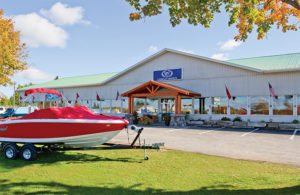
“The end result of both projects has created a warm and welcoming custom entryway along with an open and inviting showroom whereby we are able to display a total of six new boats and personal watercraft,” Lineberry says.
Paris Marine also re-tooled its product offerings in an effort to become more of a “one-stop shop” for its clientele’s cottage needs.
“Along with our standard line of superior boat lines we added an array of paddleboards, artisan handcrafted Muskoka fire pits, Aqua-Lily Pads, Maui Mats and extended our outdoor recycled plastic furniture line,” Lineberry says. “The additions of Yamaha personal watercraft and Crestliner all-welded aluminum fishing boats have been extremely well received by all of our clientele, and have allowed us to carry complementary, versus competitive products.”
The changes have resulted in positive feedback from customers and partners.
“As a direct result of our calculated actions we have garnered countless laudatory comments from the majority of our clientele base as they either visit or drive past the showroom, or visit our social media sites and see our changes,” Lineberry says. “We have also experienced a sizable increase in overall parts and accessories sales along with an increase in new client traffic based on the appearance of our showroom and our newly offered product lines.”
Investing in employees
Like many Top 100 dealers, Tobler Marina recognizes the importance of investing time and money in developing its employees.
“As we budget every year for training and review expenses I always remember a point a speaker I heard back in 1992 made, and then set budget,” says Tobler President Brent Christian. “The speaker was covering training and how important it was to train and inspect and how the expense was mandatory to success. At the end of all seminars the speaker took questions and was asked. ‘Well, what if I spend all of that money training these employees and then they leave?’ The speaker responded, ‘What if you don’t train them and they stay!’”
With constant change in the boating industry, the economy, government regulations and more, dealerships have to be able to adapt.
“The changes and demands by the customer to be satisfied enough to be a loyal customer is increasingly difficult,” Christian says. “Social media, time restraints and financial requirements of the business dictate you will learn and advance, or fail.”
All of Tobler’s employees receive training in accordance with dealer certification, industry updates, local market trends and changes. Weekly manager meetings drill down further into training on specific issues, and individual weekly department meetings are held also.
New hires spend a day reviewing detailed policy and procedure manual, process maps, and all job descriptions. This gives them an overall level of familiarity with all departments and people to know how their position interacts with others and affects their co-worker. A minimum of one day is then spent in each of the departments. They work with the supervisor, manager or employee to familiarize with the key tasks and process of that department.
For existing employees, specific job shadowing and cross training is available to improve the diversity of their skills, making it easier for them to advance in the company.
Improve the store, not the score
The Port Harbor Marine team believes that true customer satisfaction is more about the company’s culture than an individual strategy.
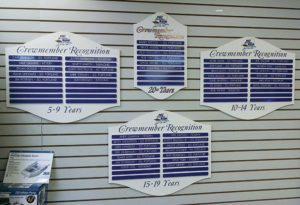
“Our strategy is designed to improve the store first and then use mechanisms to ensure we are getting the scores we deserve,” says President Rob Soucy. “The first thing we work on is our culture. Our vision statement reads that ‘we want to be the only company that anyone would ever want to buy boating products and services from’ and we support that vision with a mission of ‘creating the ultimate boating experience.’”
This vision and mission is achieved by adhering to a set of company core values that guide Port Harbor’s crewmembers to do the right things. Those values drive habits and habits drive culture, Soucy says.
“Actual CSI scores are not our primary focus, customer loyalty is,” Soucy says. “Our approach is much like that of the one described in the book, ‘The Ultimate Question.’ We are not fixated on the ‘completely satisfied’ score but whether customers would come back and recommend us. This is the true measurement of customer loyalty.”
To more directly improve CSI, Port Harbor changed the role of its sales assistant and made the position responsible for 100 percent of the post sale and delivery follow up. An extensive pre- and post-delivery process helps to ensure customer satisfaction and quick response to any issues.
“All of these formal contacts are supported by ongoing communication through our personalized service program and with the array of customer events we engage in,” Soucy says. “We have also implemented new initiatives in our service department to improve the CSI scores. Service coordinators are now charged with the responsibility of improving scores and have a bonus tied to their performance. The importance of CSI and practices to improve our customer experience are discussed at all company meetings as well as monthly managers meetings and weekly sales and service meetings.”




